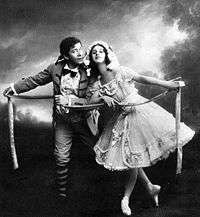Nikolai Legat
Nikolai Gustavovich Legat (Russian: Никола́й Густа́вович Лега́т) (30 December 1869, Moscow – 24 January 1937, London), was a premier dancer with the Russian Imperial Ballet from 1888 to 1914, and also with the Mariinsky Ballet. Both he and his younger brother, Sergey, became ballet masters and caricaturists.

Nicolai, son of Gustav, is considered to be the main successor to Pavel Gerdt. Legat later served as a balletmaster in Russia, teaching and passing on the repertoire of the Imperial ballet company, whose groundwork was the legacy of the great choreographer-balletmaster, Marius Petipa. He left Russia with his second wife, Nadine, in 1922 and eventually settled in England in 1926. The couple opened their first ballet school in Kent. They were later able to start classes in Hammersmith, London. Among their notable pupils were Ninette de Valois and Margot Fonteyn.[1]
Legat's wife, Nadine Nicolaeva, was Prima Ballerina of the Imperial and State theatres of Moscow and St. Petersburg. She choreographed dances based on the Movements Exercises of Gurdjieff and later founded the Legat School of Ballet in Kent. One of her students was Anneliese von Oettingen.[2] Nadine Nicolaeva-Legat was a follower of P. D. Ouspensky. She choreographed dances based on the Movements Exercises of G. I Gurdjieff. In 1938, Ouspensky and his followers acquired Colet House in London, from Nadine Legat, where they established the Historico-Psychological Society.[3]
See also
References
- Amy Growcott: biography of Nicolai Legat The Marius Petipa Society Nikolai and Sergei Legat Retrieved 27 June 2019.
- "Anneliese von Oettingen". Who Are We?. Anneliese von Oettingen Ballet. Retrieved 12 August 2011.
- Webb, James. The Harmonious Circle: The Lives and Work of G. I. Gurdjieff, P. D. Ouspensky and Their Followers (1980), p 409.